Application of Quantitative Methods in Dairy Supply Chain: Review
VerifiedAdded on 2020/12/31
|12
|3063
|19
Literature Review
AI Summary
This literature review examines the application of quantitative methods in the design and analysis of dairy supply chains, focusing on the Australian dairy industry. The review explores various aspects of supply chain management, including design, analysis, and the integration of key business processes. Several articles are analyzed, highlighting the use of multi-objective functions for cost minimization, the identification of issues within informal channels, and the application of confirmatory models and factor analysis for supply chain coordination. Fuzzy mixed-integer programming, bi-objective programming, and various mathematical formulae are discussed as tools for optimizing facility locations, distribution systems, and export competitiveness. The review also covers the use of parsimonious models for reducing greenhouse gas emissions, Poisson distribution for studying milk safety measures, and technology adoption for improving production performance. The limitations of the research, such as the complexity of mathematical models and the need for expert interpretation, are also addressed. The findings emphasize the importance of SCM in minimizing costs, maximizing customer service, and increasing flexibility, with a focus on the integration of raw material sourcing, production, transportation, and warehousing within a four-echelon supply chain model. The review concludes by highlighting the role of fuzzy systems in enhancing production and distribution activities to achieve supply chain sustainability in the dairy industry.

Literature Review on Application of
Quantitative Methods in Design and
Analysis of Dairy Supply Chain
Quantitative Methods in Design and
Analysis of Dairy Supply Chain
Paraphrase This Document
Need a fresh take? Get an instant paraphrase of this document with our AI Paraphraser

Table of Contents
Title: Literature Review on Application of Quantitative Methods in Design and Analysis of
“Dairy Supply Chain”......................................................................................................................1
Supply Chain Design..............................................................................................................1
Supply Chain Analysis...........................................................................................................3
Summary of Findings.............................................................................................................6
REFERENCES................................................................................................................................7
Title: Literature Review on Application of Quantitative Methods in Design and Analysis of
“Dairy Supply Chain”......................................................................................................................1
Supply Chain Design..............................................................................................................1
Supply Chain Analysis...........................................................................................................3
Summary of Findings.............................................................................................................6
REFERENCES................................................................................................................................7

⊘ This is a preview!⊘
Do you want full access?
Subscribe today to unlock all pages.

Trusted by 1+ million students worldwide
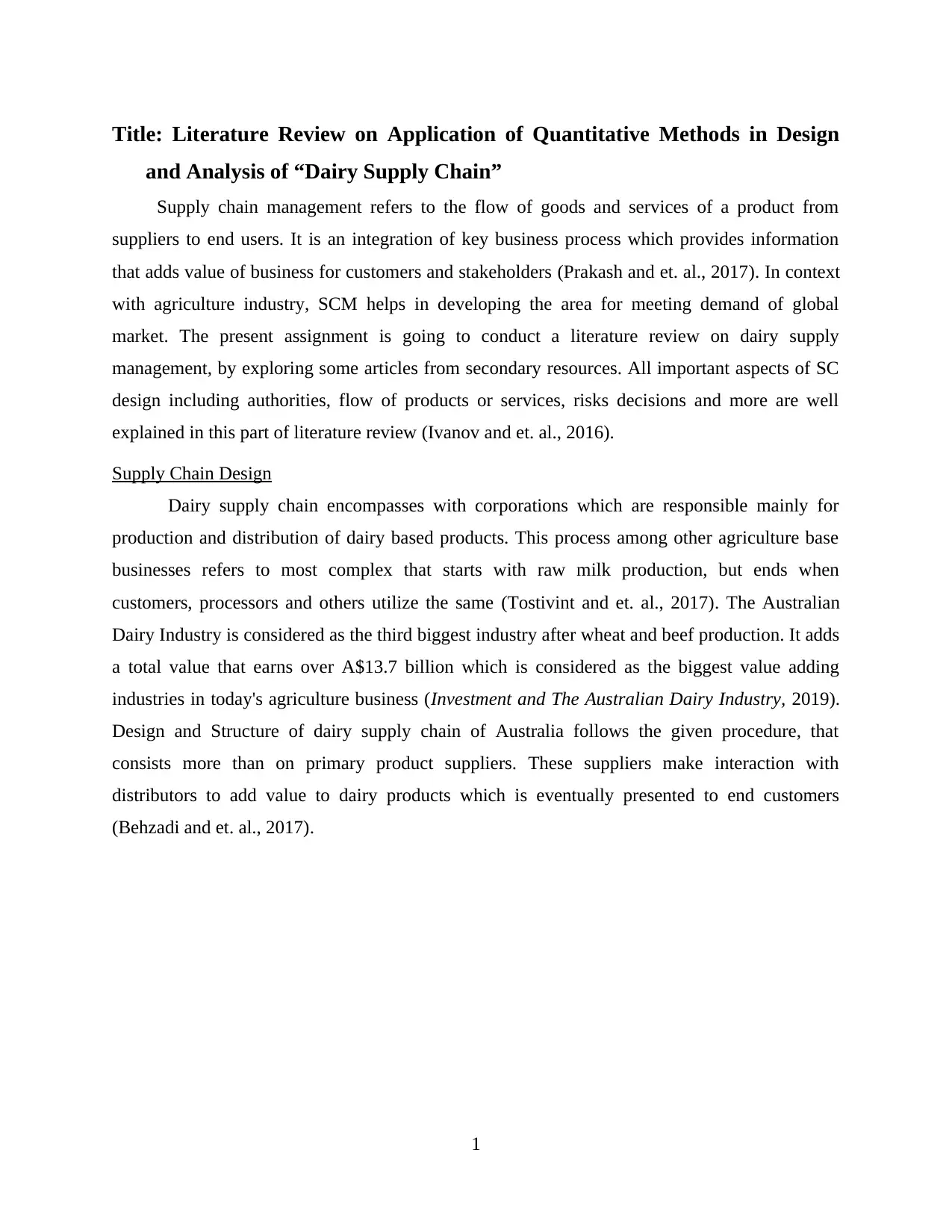
Title: Literature Review on Application of Quantitative Methods in Design
and Analysis of “Dairy Supply Chain”
Supply chain management refers to the flow of goods and services of a product from
suppliers to end users. It is an integration of key business process which provides information
that adds value of business for customers and stakeholders (Prakash and et. al., 2017). In context
with agriculture industry, SCM helps in developing the area for meeting demand of global
market. The present assignment is going to conduct a literature review on dairy supply
management, by exploring some articles from secondary resources. All important aspects of SC
design including authorities, flow of products or services, risks decisions and more are well
explained in this part of literature review (Ivanov and et. al., 2016).
Supply Chain Design
Dairy supply chain encompasses with corporations which are responsible mainly for
production and distribution of dairy based products. This process among other agriculture base
businesses refers to most complex that starts with raw milk production, but ends when
customers, processors and others utilize the same (Tostivint and et. al., 2017). The Australian
Dairy Industry is considered as the third biggest industry after wheat and beef production. It adds
a total value that earns over A$13.7 billion which is considered as the biggest value adding
industries in today's agriculture business (Investment and The Australian Dairy Industry, 2019).
Design and Structure of dairy supply chain of Australia follows the given procedure, that
consists more than on primary product suppliers. These suppliers make interaction with
distributors to add value to dairy products which is eventually presented to end customers
(Behzadi and et. al., 2017).
1
and Analysis of “Dairy Supply Chain”
Supply chain management refers to the flow of goods and services of a product from
suppliers to end users. It is an integration of key business process which provides information
that adds value of business for customers and stakeholders (Prakash and et. al., 2017). In context
with agriculture industry, SCM helps in developing the area for meeting demand of global
market. The present assignment is going to conduct a literature review on dairy supply
management, by exploring some articles from secondary resources. All important aspects of SC
design including authorities, flow of products or services, risks decisions and more are well
explained in this part of literature review (Ivanov and et. al., 2016).
Supply Chain Design
Dairy supply chain encompasses with corporations which are responsible mainly for
production and distribution of dairy based products. This process among other agriculture base
businesses refers to most complex that starts with raw milk production, but ends when
customers, processors and others utilize the same (Tostivint and et. al., 2017). The Australian
Dairy Industry is considered as the third biggest industry after wheat and beef production. It adds
a total value that earns over A$13.7 billion which is considered as the biggest value adding
industries in today's agriculture business (Investment and The Australian Dairy Industry, 2019).
Design and Structure of dairy supply chain of Australia follows the given procedure, that
consists more than on primary product suppliers. These suppliers make interaction with
distributors to add value to dairy products which is eventually presented to end customers
(Behzadi and et. al., 2017).
1
Paraphrase This Document
Need a fresh take? Get an instant paraphrase of this document with our AI Paraphraser

Dairy farmers and Australian industries work in cooperation with a range of key partners
that includes: DataGene, DairyBio, Dairy Management Inc., Geoffrey Gardiner Dairy
Foundation, De Laval, Department of Agriculture and Food Western Australia, Department of
Agriculture and Water Resources, Dairy Manufacturer's Sustainability Council etc. All these
organisations collaborate together as collective for ensuring better outcomes (Palmieri, Forleo
and Salimei, 2017). Here, in dairy supply chain of Australia, flow of products or services can
also be well-defined by given figure:-
2
that includes: DataGene, DairyBio, Dairy Management Inc., Geoffrey Gardiner Dairy
Foundation, De Laval, Department of Agriculture and Food Western Australia, Department of
Agriculture and Water Resources, Dairy Manufacturer's Sustainability Council etc. All these
organisations collaborate together as collective for ensuring better outcomes (Palmieri, Forleo
and Salimei, 2017). Here, in dairy supply chain of Australia, flow of products or services can
also be well-defined by given figure:-
2
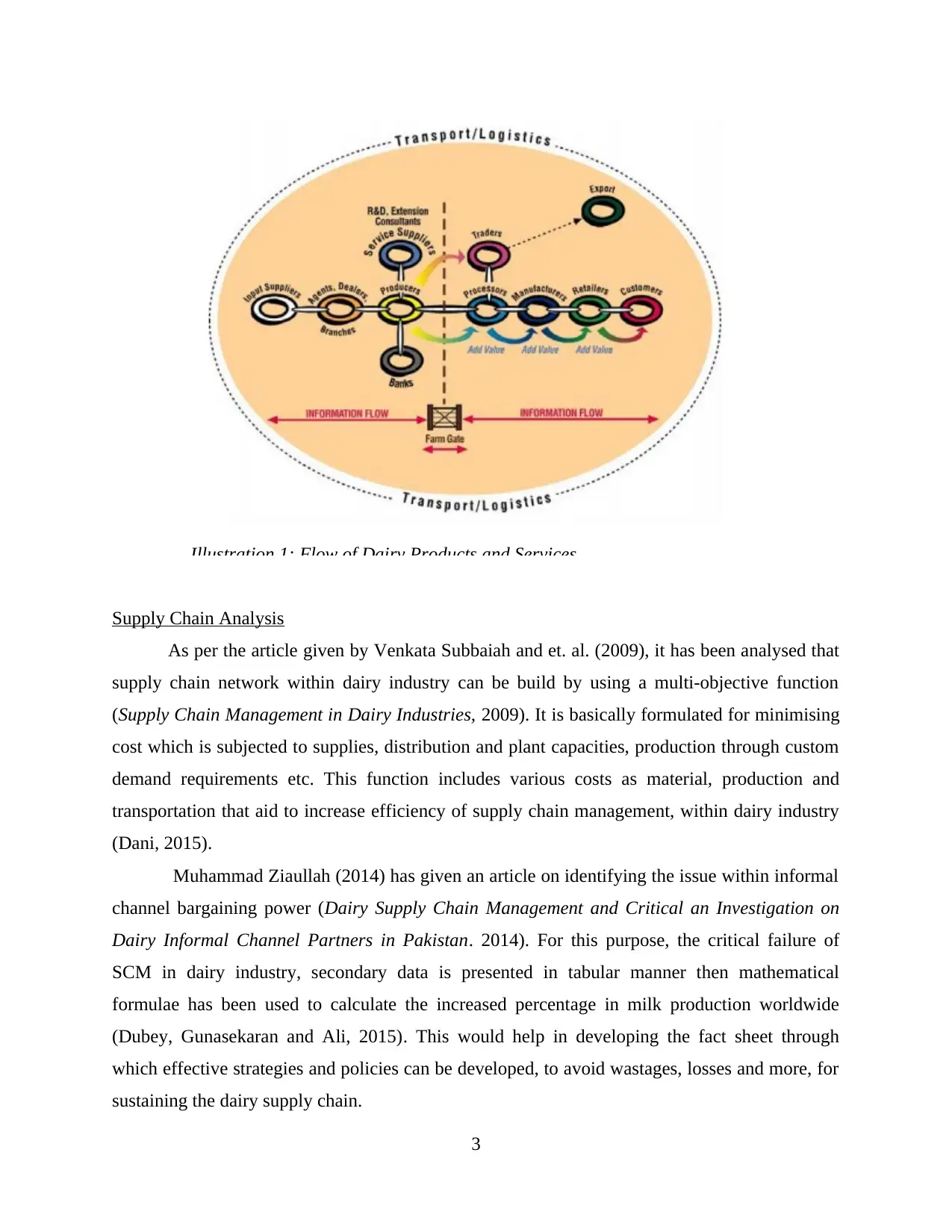
Supply Chain Analysis
As per the article given by Venkata Subbaiah and et. al. (2009), it has been analysed that
supply chain network within dairy industry can be build by using a multi-objective function
(Supply Chain Management in Dairy Industries, 2009). It is basically formulated for minimising
cost which is subjected to supplies, distribution and plant capacities, production through custom
demand requirements etc. This function includes various costs as material, production and
transportation that aid to increase efficiency of supply chain management, within dairy industry
(Dani, 2015).
Muhammad Ziaullah (2014) has given an article on identifying the issue within informal
channel bargaining power (Dairy Supply Chain Management and Critical an Investigation on
Dairy Informal Channel Partners in Pakistan. 2014). For this purpose, the critical failure of
SCM in dairy industry, secondary data is presented in tabular manner then mathematical
formulae has been used to calculate the increased percentage in milk production worldwide
(Dubey, Gunasekaran and Ali, 2015). This would help in developing the fact sheet through
which effective strategies and policies can be developed, to avoid wastages, losses and more, for
sustaining the dairy supply chain.
3
Illustration 1: Flow of Dairy Products and Services
As per the article given by Venkata Subbaiah and et. al. (2009), it has been analysed that
supply chain network within dairy industry can be build by using a multi-objective function
(Supply Chain Management in Dairy Industries, 2009). It is basically formulated for minimising
cost which is subjected to supplies, distribution and plant capacities, production through custom
demand requirements etc. This function includes various costs as material, production and
transportation that aid to increase efficiency of supply chain management, within dairy industry
(Dani, 2015).
Muhammad Ziaullah (2014) has given an article on identifying the issue within informal
channel bargaining power (Dairy Supply Chain Management and Critical an Investigation on
Dairy Informal Channel Partners in Pakistan. 2014). For this purpose, the critical failure of
SCM in dairy industry, secondary data is presented in tabular manner then mathematical
formulae has been used to calculate the increased percentage in milk production worldwide
(Dubey, Gunasekaran and Ali, 2015). This would help in developing the fact sheet through
which effective strategies and policies can be developed, to avoid wastages, losses and more, for
sustaining the dairy supply chain.
3
Illustration 1: Flow of Dairy Products and Services
⊘ This is a preview!⊘
Do you want full access?
Subscribe today to unlock all pages.

Trusted by 1+ million students worldwide
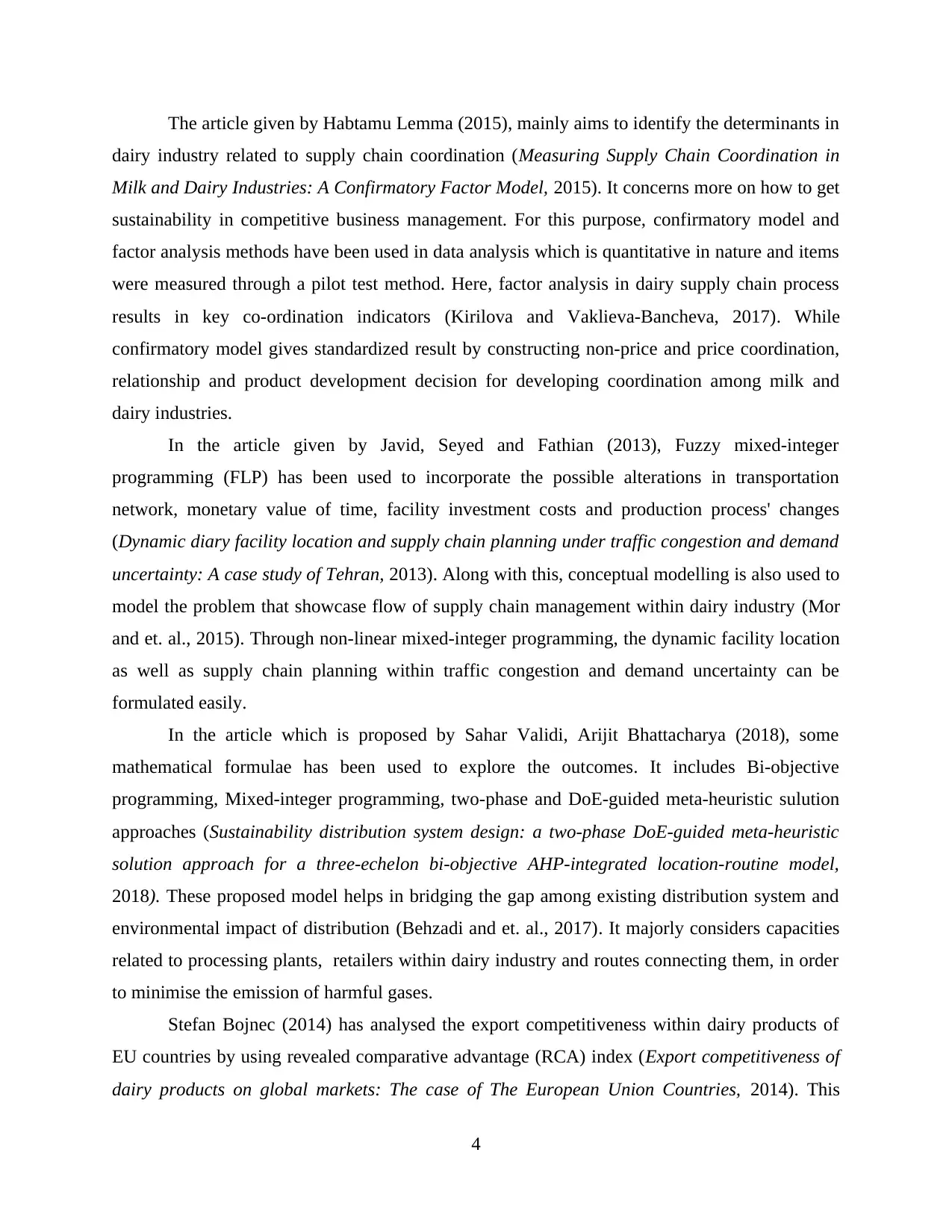
The article given by Habtamu Lemma (2015), mainly aims to identify the determinants in
dairy industry related to supply chain coordination (Measuring Supply Chain Coordination in
Milk and Dairy Industries: A Confirmatory Factor Model, 2015). It concerns more on how to get
sustainability in competitive business management. For this purpose, confirmatory model and
factor analysis methods have been used in data analysis which is quantitative in nature and items
were measured through a pilot test method. Here, factor analysis in dairy supply chain process
results in key co-ordination indicators (Kirilova and Vaklieva-Bancheva, 2017). While
confirmatory model gives standardized result by constructing non-price and price coordination,
relationship and product development decision for developing coordination among milk and
dairy industries.
In the article given by Javid, Seyed and Fathian (2013), Fuzzy mixed-integer
programming (FLP) has been used to incorporate the possible alterations in transportation
network, monetary value of time, facility investment costs and production process' changes
(Dynamic diary facility location and supply chain planning under traffic congestion and demand
uncertainty: A case study of Tehran, 2013). Along with this, conceptual modelling is also used to
model the problem that showcase flow of supply chain management within dairy industry (Mor
and et. al., 2015). Through non-linear mixed-integer programming, the dynamic facility location
as well as supply chain planning within traffic congestion and demand uncertainty can be
formulated easily.
In the article which is proposed by Sahar Validi, Arijit Bhattacharya (2018), some
mathematical formulae has been used to explore the outcomes. It includes Bi-objective
programming, Mixed-integer programming, two-phase and DoE-guided meta-heuristic sulution
approaches (Sustainability distribution system design: a two-phase DoE-guided meta-heuristic
solution approach for a three-echelon bi-objective AHP-integrated location-routine model,
2018). These proposed model helps in bridging the gap among existing distribution system and
environmental impact of distribution (Behzadi and et. al., 2017). It majorly considers capacities
related to processing plants, retailers within dairy industry and routes connecting them, in order
to minimise the emission of harmful gases.
Stefan Bojnec (2014) has analysed the export competitiveness within dairy products of
EU countries by using revealed comparative advantage (RCA) index (Export competitiveness of
dairy products on global markets: The case of The European Union Countries, 2014). This
4
dairy industry related to supply chain coordination (Measuring Supply Chain Coordination in
Milk and Dairy Industries: A Confirmatory Factor Model, 2015). It concerns more on how to get
sustainability in competitive business management. For this purpose, confirmatory model and
factor analysis methods have been used in data analysis which is quantitative in nature and items
were measured through a pilot test method. Here, factor analysis in dairy supply chain process
results in key co-ordination indicators (Kirilova and Vaklieva-Bancheva, 2017). While
confirmatory model gives standardized result by constructing non-price and price coordination,
relationship and product development decision for developing coordination among milk and
dairy industries.
In the article given by Javid, Seyed and Fathian (2013), Fuzzy mixed-integer
programming (FLP) has been used to incorporate the possible alterations in transportation
network, monetary value of time, facility investment costs and production process' changes
(Dynamic diary facility location and supply chain planning under traffic congestion and demand
uncertainty: A case study of Tehran, 2013). Along with this, conceptual modelling is also used to
model the problem that showcase flow of supply chain management within dairy industry (Mor
and et. al., 2015). Through non-linear mixed-integer programming, the dynamic facility location
as well as supply chain planning within traffic congestion and demand uncertainty can be
formulated easily.
In the article which is proposed by Sahar Validi, Arijit Bhattacharya (2018), some
mathematical formulae has been used to explore the outcomes. It includes Bi-objective
programming, Mixed-integer programming, two-phase and DoE-guided meta-heuristic sulution
approaches (Sustainability distribution system design: a two-phase DoE-guided meta-heuristic
solution approach for a three-echelon bi-objective AHP-integrated location-routine model,
2018). These proposed model helps in bridging the gap among existing distribution system and
environmental impact of distribution (Behzadi and et. al., 2017). It majorly considers capacities
related to processing plants, retailers within dairy industry and routes connecting them, in order
to minimise the emission of harmful gases.
Stefan Bojnec (2014) has analysed the export competitiveness within dairy products of
EU countries by using revealed comparative advantage (RCA) index (Export competitiveness of
dairy products on global markets: The case of The European Union Countries, 2014). This
4
Paraphrase This Document
Need a fresh take? Get an instant paraphrase of this document with our AI Paraphraser

method is mainly used in international economics to calculate relative advantages for a certain
product. In this research, it has computed the dairy products' share and measures specialisation of
a nation, by dividing share of same in global exports (Ivanov and et. al., 2016). It states that if
RCA is greater than one then such country is more specialised for a given dairy product in terms
of exports, otherwise not.
Anne and et. al. (2013) have demonstrated through their article to identify where dairy
industry need to innovate, for reducing GHG emissions in supply chain in order to achieve high
benefits (Dairy farm greenhouse gas impacts: A parsimonious model for a farmer's decision
support tool, 2013). To conduct this investigation parsimonious simplified model has been used.
It helps in identifying the key parameters of influence within dairy industry that contributes to
increase carbon footprint (Dani, 2015).
Yang, Kevin and Kong (2019) has used Poisson distribution method for studying the
determinants of adoption of different voluntary milk safety measures by farmers and other
suppliers of dairy industry (Factors affecting the adoption of on-farm milk safety measures in
Northern China-An examination from the perspective of farm size and production type, 2019).
Here, empirical result has indicated that adoption is affected in positive manner by farm size
(Prakash and et. al., 2017).
The article given by Hisham, El-Osta and Mitchell state the importance of technology in
increasing efficiency of dairy supply chain (Technology Adoption and Its Impact on Production
Performance of Dairy Operations, 2000). To perform the investigation of this topic, these
researchers have estimated a deterministic parametric frontier, including Cobb-Douglas method
for interpreting the estimates (Tostivint and et. al., 2017). Along with this, Wald F test is also
used for examining whether dairy industries gain high return on investment or not.
The article proposed by Zeki, Funda and Gulcin (2011) is based on fuzzy approach, with
main aim is to identify the logistic requirement as well as supply chain management for dairy
management (A fuzzy QFD approach to determine supply chain management strategies in the
dairy industry, 2011). For determining the best suitable logistics requirements, now dairy
industries are adopting the concept of quality function deployment in order to produce
innovation in their production and supply chain management (Palmieri, Forleo and Salimei,
2017). To analyse the concept of this approach, these researchers have used multi-objective
5
product. In this research, it has computed the dairy products' share and measures specialisation of
a nation, by dividing share of same in global exports (Ivanov and et. al., 2016). It states that if
RCA is greater than one then such country is more specialised for a given dairy product in terms
of exports, otherwise not.
Anne and et. al. (2013) have demonstrated through their article to identify where dairy
industry need to innovate, for reducing GHG emissions in supply chain in order to achieve high
benefits (Dairy farm greenhouse gas impacts: A parsimonious model for a farmer's decision
support tool, 2013). To conduct this investigation parsimonious simplified model has been used.
It helps in identifying the key parameters of influence within dairy industry that contributes to
increase carbon footprint (Dani, 2015).
Yang, Kevin and Kong (2019) has used Poisson distribution method for studying the
determinants of adoption of different voluntary milk safety measures by farmers and other
suppliers of dairy industry (Factors affecting the adoption of on-farm milk safety measures in
Northern China-An examination from the perspective of farm size and production type, 2019).
Here, empirical result has indicated that adoption is affected in positive manner by farm size
(Prakash and et. al., 2017).
The article given by Hisham, El-Osta and Mitchell state the importance of technology in
increasing efficiency of dairy supply chain (Technology Adoption and Its Impact on Production
Performance of Dairy Operations, 2000). To perform the investigation of this topic, these
researchers have estimated a deterministic parametric frontier, including Cobb-Douglas method
for interpreting the estimates (Tostivint and et. al., 2017). Along with this, Wald F test is also
used for examining whether dairy industries gain high return on investment or not.
The article proposed by Zeki, Funda and Gulcin (2011) is based on fuzzy approach, with
main aim is to identify the logistic requirement as well as supply chain management for dairy
management (A fuzzy QFD approach to determine supply chain management strategies in the
dairy industry, 2011). For determining the best suitable logistics requirements, now dairy
industries are adopting the concept of quality function deployment in order to produce
innovation in their production and supply chain management (Palmieri, Forleo and Salimei,
2017). To analyse the concept of this approach, these researchers have used multi-objective
5
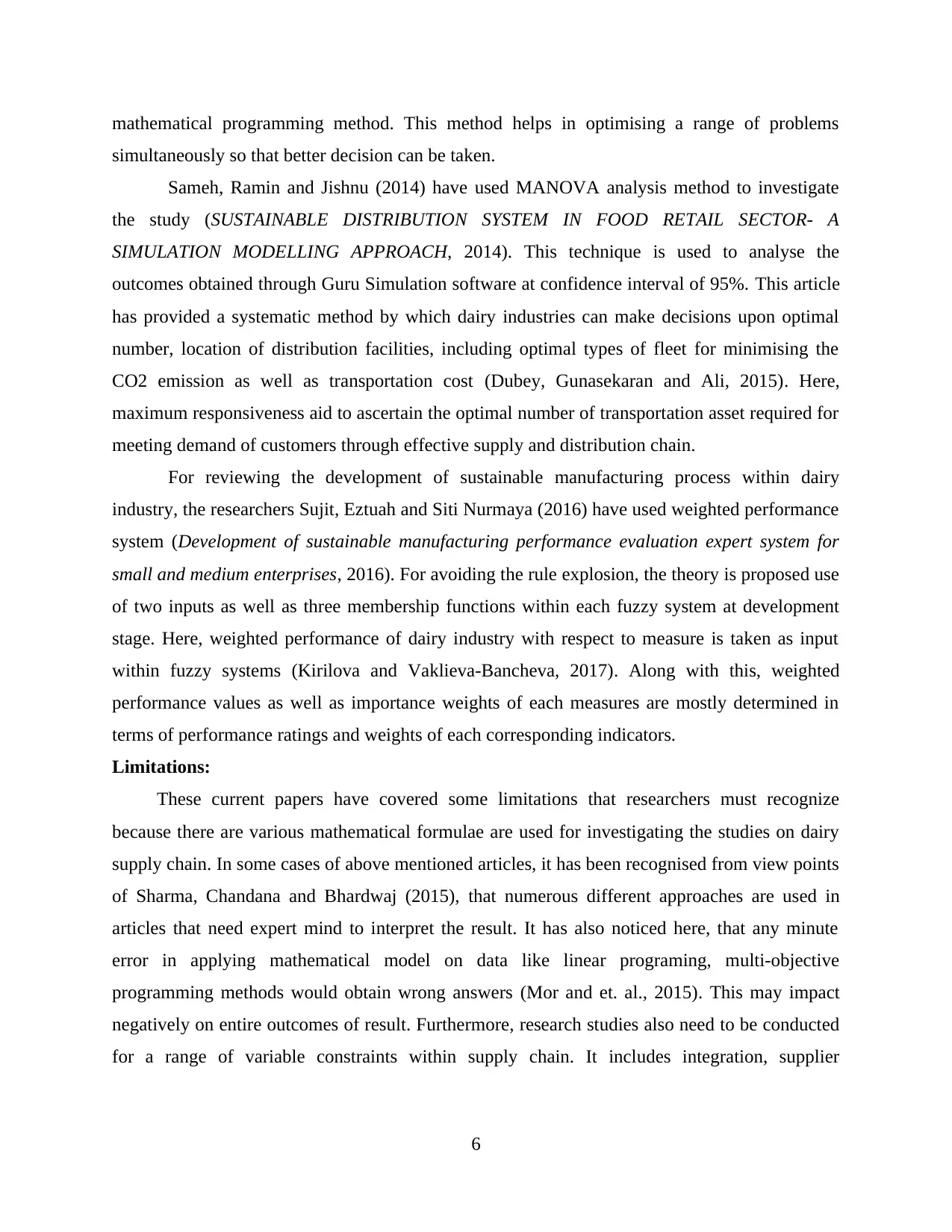
mathematical programming method. This method helps in optimising a range of problems
simultaneously so that better decision can be taken.
Sameh, Ramin and Jishnu (2014) have used MANOVA analysis method to investigate
the study (SUSTAINABLE DISTRIBUTION SYSTEM IN FOOD RETAIL SECTOR- A
SIMULATION MODELLING APPROACH, 2014). This technique is used to analyse the
outcomes obtained through Guru Simulation software at confidence interval of 95%. This article
has provided a systematic method by which dairy industries can make decisions upon optimal
number, location of distribution facilities, including optimal types of fleet for minimising the
CO2 emission as well as transportation cost (Dubey, Gunasekaran and Ali, 2015). Here,
maximum responsiveness aid to ascertain the optimal number of transportation asset required for
meeting demand of customers through effective supply and distribution chain.
For reviewing the development of sustainable manufacturing process within dairy
industry, the researchers Sujit, Eztuah and Siti Nurmaya (2016) have used weighted performance
system (Development of sustainable manufacturing performance evaluation expert system for
small and medium enterprises, 2016). For avoiding the rule explosion, the theory is proposed use
of two inputs as well as three membership functions within each fuzzy system at development
stage. Here, weighted performance of dairy industry with respect to measure is taken as input
within fuzzy systems (Kirilova and Vaklieva-Bancheva, 2017). Along with this, weighted
performance values as well as importance weights of each measures are mostly determined in
terms of performance ratings and weights of each corresponding indicators.
Limitations:
These current papers have covered some limitations that researchers must recognize
because there are various mathematical formulae are used for investigating the studies on dairy
supply chain. In some cases of above mentioned articles, it has been recognised from view points
of Sharma, Chandana and Bhardwaj (2015), that numerous different approaches are used in
articles that need expert mind to interpret the result. It has also noticed here, that any minute
error in applying mathematical model on data like linear programing, multi-objective
programming methods would obtain wrong answers (Mor and et. al., 2015). This may impact
negatively on entire outcomes of result. Furthermore, research studies also need to be conducted
for a range of variable constraints within supply chain. It includes integration, supplier
6
simultaneously so that better decision can be taken.
Sameh, Ramin and Jishnu (2014) have used MANOVA analysis method to investigate
the study (SUSTAINABLE DISTRIBUTION SYSTEM IN FOOD RETAIL SECTOR- A
SIMULATION MODELLING APPROACH, 2014). This technique is used to analyse the
outcomes obtained through Guru Simulation software at confidence interval of 95%. This article
has provided a systematic method by which dairy industries can make decisions upon optimal
number, location of distribution facilities, including optimal types of fleet for minimising the
CO2 emission as well as transportation cost (Dubey, Gunasekaran and Ali, 2015). Here,
maximum responsiveness aid to ascertain the optimal number of transportation asset required for
meeting demand of customers through effective supply and distribution chain.
For reviewing the development of sustainable manufacturing process within dairy
industry, the researchers Sujit, Eztuah and Siti Nurmaya (2016) have used weighted performance
system (Development of sustainable manufacturing performance evaluation expert system for
small and medium enterprises, 2016). For avoiding the rule explosion, the theory is proposed use
of two inputs as well as three membership functions within each fuzzy system at development
stage. Here, weighted performance of dairy industry with respect to measure is taken as input
within fuzzy systems (Kirilova and Vaklieva-Bancheva, 2017). Along with this, weighted
performance values as well as importance weights of each measures are mostly determined in
terms of performance ratings and weights of each corresponding indicators.
Limitations:
These current papers have covered some limitations that researchers must recognize
because there are various mathematical formulae are used for investigating the studies on dairy
supply chain. In some cases of above mentioned articles, it has been recognised from view points
of Sharma, Chandana and Bhardwaj (2015), that numerous different approaches are used in
articles that need expert mind to interpret the result. It has also noticed here, that any minute
error in applying mathematical model on data like linear programing, multi-objective
programming methods would obtain wrong answers (Mor and et. al., 2015). This may impact
negatively on entire outcomes of result. Furthermore, research studies also need to be conducted
for a range of variable constraints within supply chain. It includes integration, supplier
6
⊘ This is a preview!⊘
Do you want full access?
Subscribe today to unlock all pages.

Trusted by 1+ million students worldwide
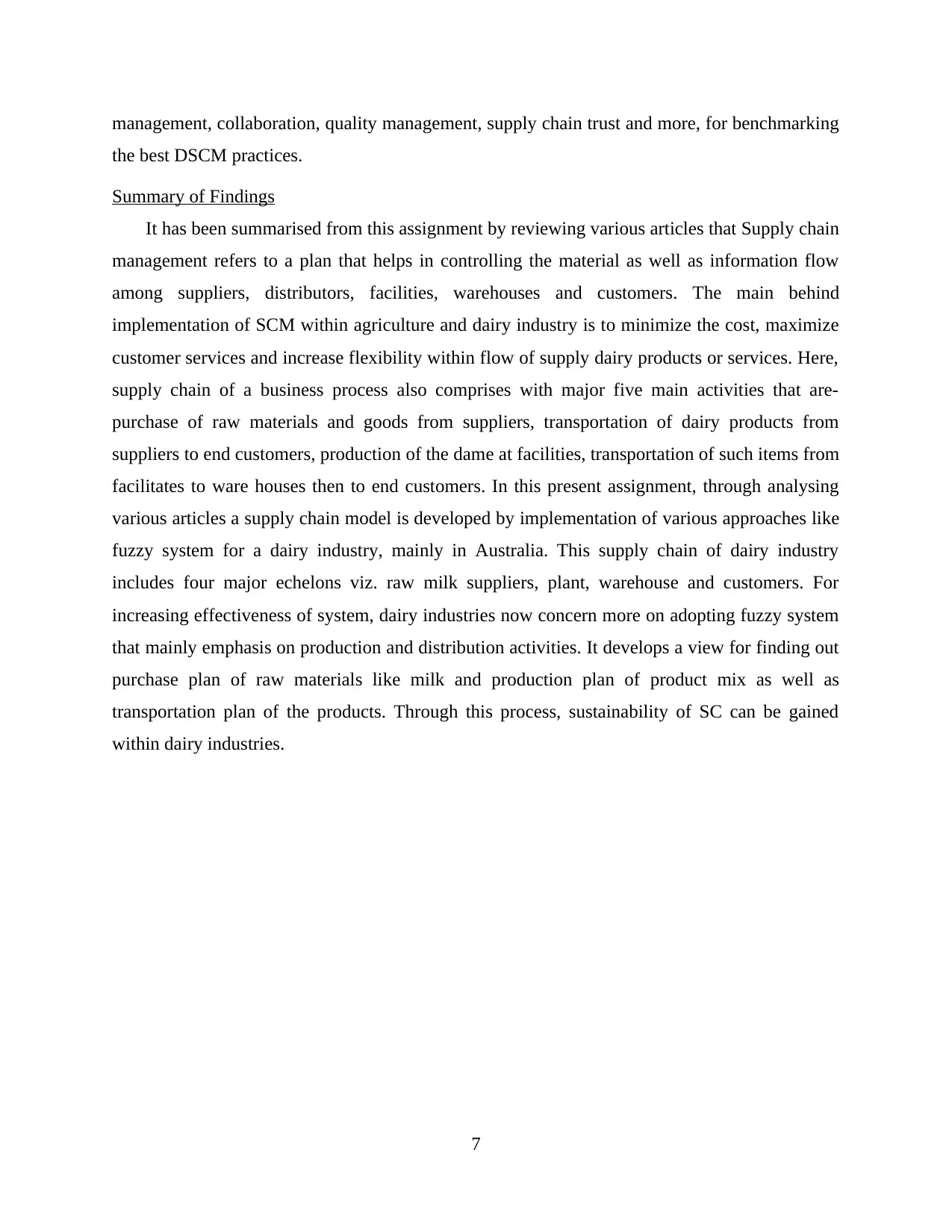
management, collaboration, quality management, supply chain trust and more, for benchmarking
the best DSCM practices.
Summary of Findings
It has been summarised from this assignment by reviewing various articles that Supply chain
management refers to a plan that helps in controlling the material as well as information flow
among suppliers, distributors, facilities, warehouses and customers. The main behind
implementation of SCM within agriculture and dairy industry is to minimize the cost, maximize
customer services and increase flexibility within flow of supply dairy products or services. Here,
supply chain of a business process also comprises with major five main activities that are-
purchase of raw materials and goods from suppliers, transportation of dairy products from
suppliers to end customers, production of the dame at facilities, transportation of such items from
facilitates to ware houses then to end customers. In this present assignment, through analysing
various articles a supply chain model is developed by implementation of various approaches like
fuzzy system for a dairy industry, mainly in Australia. This supply chain of dairy industry
includes four major echelons viz. raw milk suppliers, plant, warehouse and customers. For
increasing effectiveness of system, dairy industries now concern more on adopting fuzzy system
that mainly emphasis on production and distribution activities. It develops a view for finding out
purchase plan of raw materials like milk and production plan of product mix as well as
transportation plan of the products. Through this process, sustainability of SC can be gained
within dairy industries.
7
the best DSCM practices.
Summary of Findings
It has been summarised from this assignment by reviewing various articles that Supply chain
management refers to a plan that helps in controlling the material as well as information flow
among suppliers, distributors, facilities, warehouses and customers. The main behind
implementation of SCM within agriculture and dairy industry is to minimize the cost, maximize
customer services and increase flexibility within flow of supply dairy products or services. Here,
supply chain of a business process also comprises with major five main activities that are-
purchase of raw materials and goods from suppliers, transportation of dairy products from
suppliers to end customers, production of the dame at facilities, transportation of such items from
facilitates to ware houses then to end customers. In this present assignment, through analysing
various articles a supply chain model is developed by implementation of various approaches like
fuzzy system for a dairy industry, mainly in Australia. This supply chain of dairy industry
includes four major echelons viz. raw milk suppliers, plant, warehouse and customers. For
increasing effectiveness of system, dairy industries now concern more on adopting fuzzy system
that mainly emphasis on production and distribution activities. It develops a view for finding out
purchase plan of raw materials like milk and production plan of product mix as well as
transportation plan of the products. Through this process, sustainability of SC can be gained
within dairy industries.
7
Paraphrase This Document
Need a fresh take? Get an instant paraphrase of this document with our AI Paraphraser
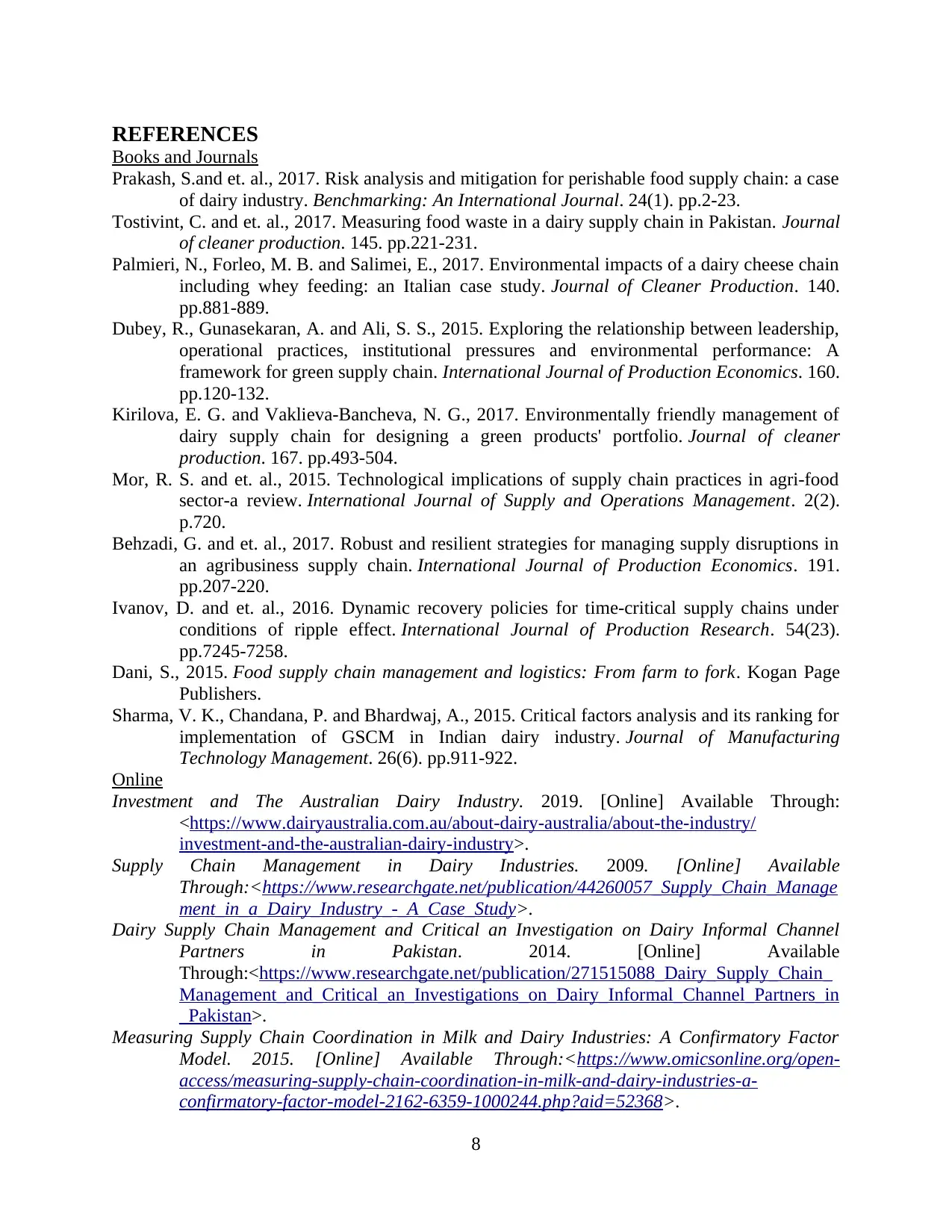
REFERENCES
Books and Journals
Prakash, S.and et. al., 2017. Risk analysis and mitigation for perishable food supply chain: a case
of dairy industry. Benchmarking: An International Journal. 24(1). pp.2-23.
Tostivint, C. and et. al., 2017. Measuring food waste in a dairy supply chain in Pakistan. Journal
of cleaner production. 145. pp.221-231.
Palmieri, N., Forleo, M. B. and Salimei, E., 2017. Environmental impacts of a dairy cheese chain
including whey feeding: an Italian case study. Journal of Cleaner Production. 140.
pp.881-889.
Dubey, R., Gunasekaran, A. and Ali, S. S., 2015. Exploring the relationship between leadership,
operational practices, institutional pressures and environmental performance: A
framework for green supply chain. International Journal of Production Economics. 160.
pp.120-132.
Kirilova, E. G. and Vaklieva-Bancheva, N. G., 2017. Environmentally friendly management of
dairy supply chain for designing a green products' portfolio. Journal of cleaner
production. 167. pp.493-504.
Mor, R. S. and et. al., 2015. Technological implications of supply chain practices in agri-food
sector-a review. International Journal of Supply and Operations Management. 2(2).
p.720.
Behzadi, G. and et. al., 2017. Robust and resilient strategies for managing supply disruptions in
an agribusiness supply chain. International Journal of Production Economics. 191.
pp.207-220.
Ivanov, D. and et. al., 2016. Dynamic recovery policies for time-critical supply chains under
conditions of ripple effect. International Journal of Production Research. 54(23).
pp.7245-7258.
Dani, S., 2015. Food supply chain management and logistics: From farm to fork. Kogan Page
Publishers.
Sharma, V. K., Chandana, P. and Bhardwaj, A., 2015. Critical factors analysis and its ranking for
implementation of GSCM in Indian dairy industry. Journal of Manufacturing
Technology Management. 26(6). pp.911-922.
Online
Investment and The Australian Dairy Industry. 2019. [Online] Available Through:
<https://www.dairyaustralia.com.au/about-dairy-australia/about-the-industry/
investment-and-the-australian-dairy-industry>.
Supply Chain Management in Dairy Industries. 2009. [Online] Available
Through:<https://www.researchgate.net/publication/44260057_Supply_Chain_Manage
ment_in_a_Dairy_Industry_-_A_Case_Study>.
Dairy Supply Chain Management and Critical an Investigation on Dairy Informal Channel
Partners in Pakistan. 2014. [Online] Available
Through:<https://www.researchgate.net/publication/271515088_Dairy_Supply_Chain_
Management_and_Critical_an_Investigations_on_Dairy_Informal_Channel_Partners_in
_Pakistan>.
Measuring Supply Chain Coordination in Milk and Dairy Industries: A Confirmatory Factor
Model. 2015. [Online] Available Through:<https://www.omicsonline.org/open-
access/measuring-supply-chain-coordination-in-milk-and-dairy-industries-a-
confirmatory-factor-model-2162-6359-1000244.php?aid=52368>.
8
Books and Journals
Prakash, S.and et. al., 2017. Risk analysis and mitigation for perishable food supply chain: a case
of dairy industry. Benchmarking: An International Journal. 24(1). pp.2-23.
Tostivint, C. and et. al., 2017. Measuring food waste in a dairy supply chain in Pakistan. Journal
of cleaner production. 145. pp.221-231.
Palmieri, N., Forleo, M. B. and Salimei, E., 2017. Environmental impacts of a dairy cheese chain
including whey feeding: an Italian case study. Journal of Cleaner Production. 140.
pp.881-889.
Dubey, R., Gunasekaran, A. and Ali, S. S., 2015. Exploring the relationship between leadership,
operational practices, institutional pressures and environmental performance: A
framework for green supply chain. International Journal of Production Economics. 160.
pp.120-132.
Kirilova, E. G. and Vaklieva-Bancheva, N. G., 2017. Environmentally friendly management of
dairy supply chain for designing a green products' portfolio. Journal of cleaner
production. 167. pp.493-504.
Mor, R. S. and et. al., 2015. Technological implications of supply chain practices in agri-food
sector-a review. International Journal of Supply and Operations Management. 2(2).
p.720.
Behzadi, G. and et. al., 2017. Robust and resilient strategies for managing supply disruptions in
an agribusiness supply chain. International Journal of Production Economics. 191.
pp.207-220.
Ivanov, D. and et. al., 2016. Dynamic recovery policies for time-critical supply chains under
conditions of ripple effect. International Journal of Production Research. 54(23).
pp.7245-7258.
Dani, S., 2015. Food supply chain management and logistics: From farm to fork. Kogan Page
Publishers.
Sharma, V. K., Chandana, P. and Bhardwaj, A., 2015. Critical factors analysis and its ranking for
implementation of GSCM in Indian dairy industry. Journal of Manufacturing
Technology Management. 26(6). pp.911-922.
Online
Investment and The Australian Dairy Industry. 2019. [Online] Available Through:
<https://www.dairyaustralia.com.au/about-dairy-australia/about-the-industry/
investment-and-the-australian-dairy-industry>.
Supply Chain Management in Dairy Industries. 2009. [Online] Available
Through:<https://www.researchgate.net/publication/44260057_Supply_Chain_Manage
ment_in_a_Dairy_Industry_-_A_Case_Study>.
Dairy Supply Chain Management and Critical an Investigation on Dairy Informal Channel
Partners in Pakistan. 2014. [Online] Available
Through:<https://www.researchgate.net/publication/271515088_Dairy_Supply_Chain_
Management_and_Critical_an_Investigations_on_Dairy_Informal_Channel_Partners_in
_Pakistan>.
Measuring Supply Chain Coordination in Milk and Dairy Industries: A Confirmatory Factor
Model. 2015. [Online] Available Through:<https://www.omicsonline.org/open-
access/measuring-supply-chain-coordination-in-milk-and-dairy-industries-a-
confirmatory-factor-model-2162-6359-1000244.php?aid=52368>.
8
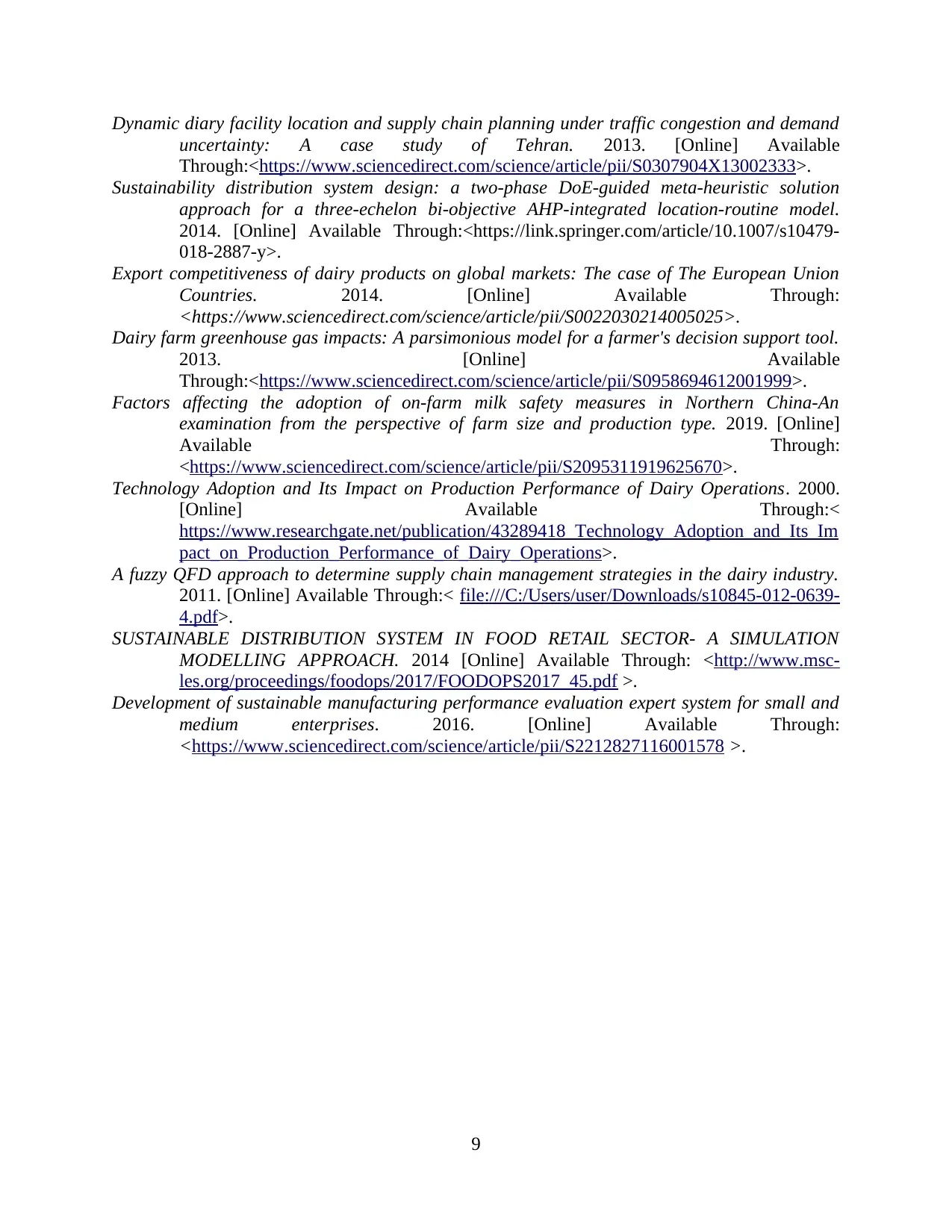
Dynamic diary facility location and supply chain planning under traffic congestion and demand
uncertainty: A case study of Tehran. 2013. [Online] Available
Through:<https://www.sciencedirect.com/science/article/pii/S0307904X13002333>.
Sustainability distribution system design: a two-phase DoE-guided meta-heuristic solution
approach for a three-echelon bi-objective AHP-integrated location-routine model.
2014. [Online] Available Through:<https://link.springer.com/article/10.1007/s10479-
018-2887-y>.
Export competitiveness of dairy products on global markets: The case of The European Union
Countries. 2014. [Online] Available Through:
<https://www.sciencedirect.com/science/article/pii/S0022030214005025>.
Dairy farm greenhouse gas impacts: A parsimonious model for a farmer's decision support tool.
2013. [Online] Available
Through:<https://www.sciencedirect.com/science/article/pii/S0958694612001999>.
Factors affecting the adoption of on-farm milk safety measures in Northern China-An
examination from the perspective of farm size and production type. 2019. [Online]
Available Through:
<https://www.sciencedirect.com/science/article/pii/S2095311919625670>.
Technology Adoption and Its Impact on Production Performance of Dairy Operations. 2000.
[Online] Available Through:<
https://www.researchgate.net/publication/43289418_Technology_Adoption_and_Its_Im
pact_on_Production_Performance_of_Dairy_Operations>.
A fuzzy QFD approach to determine supply chain management strategies in the dairy industry.
2011. [Online] Available Through:< file:///C:/Users/user/Downloads/s10845-012-0639-
4.pdf>.
SUSTAINABLE DISTRIBUTION SYSTEM IN FOOD RETAIL SECTOR- A SIMULATION
MODELLING APPROACH. 2014 [Online] Available Through: <http://www.msc-
les.org/proceedings/foodops/2017/FOODOPS2017_45.pdf >.
Development of sustainable manufacturing performance evaluation expert system for small and
medium enterprises. 2016. [Online] Available Through:
<https://www.sciencedirect.com/science/article/pii/S2212827116001578 >.
9
uncertainty: A case study of Tehran. 2013. [Online] Available
Through:<https://www.sciencedirect.com/science/article/pii/S0307904X13002333>.
Sustainability distribution system design: a two-phase DoE-guided meta-heuristic solution
approach for a three-echelon bi-objective AHP-integrated location-routine model.
2014. [Online] Available Through:<https://link.springer.com/article/10.1007/s10479-
018-2887-y>.
Export competitiveness of dairy products on global markets: The case of The European Union
Countries. 2014. [Online] Available Through:
<https://www.sciencedirect.com/science/article/pii/S0022030214005025>.
Dairy farm greenhouse gas impacts: A parsimonious model for a farmer's decision support tool.
2013. [Online] Available
Through:<https://www.sciencedirect.com/science/article/pii/S0958694612001999>.
Factors affecting the adoption of on-farm milk safety measures in Northern China-An
examination from the perspective of farm size and production type. 2019. [Online]
Available Through:
<https://www.sciencedirect.com/science/article/pii/S2095311919625670>.
Technology Adoption and Its Impact on Production Performance of Dairy Operations. 2000.
[Online] Available Through:<
https://www.researchgate.net/publication/43289418_Technology_Adoption_and_Its_Im
pact_on_Production_Performance_of_Dairy_Operations>.
A fuzzy QFD approach to determine supply chain management strategies in the dairy industry.
2011. [Online] Available Through:< file:///C:/Users/user/Downloads/s10845-012-0639-
4.pdf>.
SUSTAINABLE DISTRIBUTION SYSTEM IN FOOD RETAIL SECTOR- A SIMULATION
MODELLING APPROACH. 2014 [Online] Available Through: <http://www.msc-
les.org/proceedings/foodops/2017/FOODOPS2017_45.pdf >.
Development of sustainable manufacturing performance evaluation expert system for small and
medium enterprises. 2016. [Online] Available Through:
<https://www.sciencedirect.com/science/article/pii/S2212827116001578 >.
9
⊘ This is a preview!⊘
Do you want full access?
Subscribe today to unlock all pages.

Trusted by 1+ million students worldwide
1 out of 12
Related Documents
Your All-in-One AI-Powered Toolkit for Academic Success.
+13062052269
info@desklib.com
Available 24*7 on WhatsApp / Email
![[object Object]](/_next/static/media/star-bottom.7253800d.svg)
Unlock your academic potential
Copyright © 2020–2025 A2Z Services. All Rights Reserved. Developed and managed by ZUCOL.





